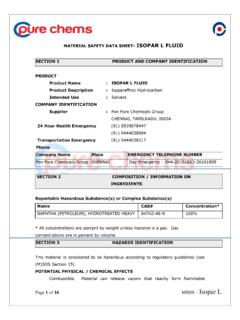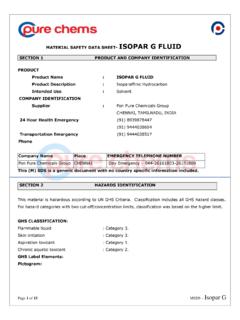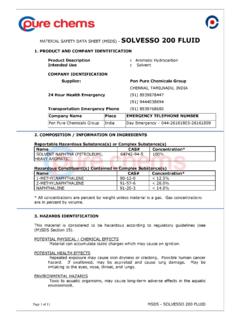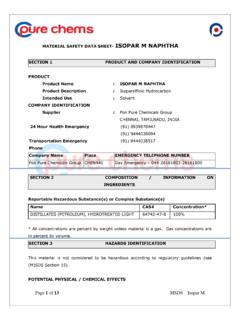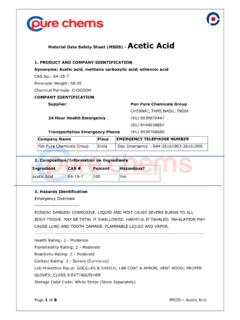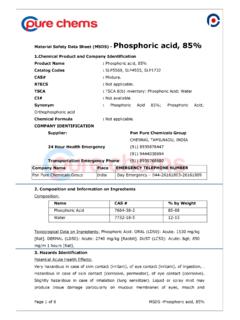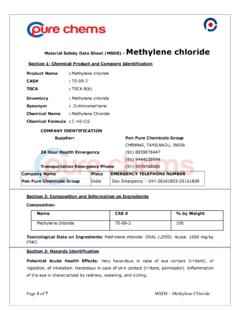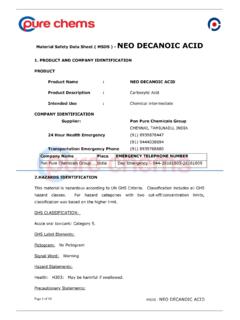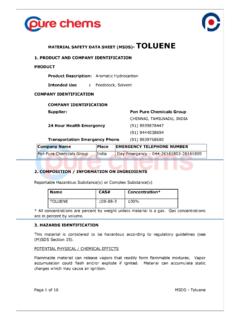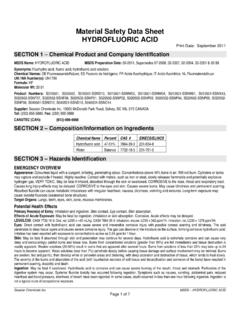Transcription of MATERIAL SAFETY DATA SHEET (MSDS) STYRENE …
1 msds - STYRENE Page 1 of 9 MATERIAL SAFETY data SHEET ( msds ) - STYRENE (Stabilized) 1. Product Identification Synonyms : STYRENE Monomer; Vinylbenzene; Phenylethylene; Styrol; Cinnamene; Ethenylbenzene CAS No. : 100-42-5 Molecular Weight : Chemical Formula : C6H5CH:CH2 COMPANY IDENTIFICATION Supplier: Pon Pure Chemicals Group CHENNAI, TAMILNADU, INDIA 24 Hour Health Emergency (91) 8939878447 (91) 9444038694 Transportation Emergency Phone (91) 8939768680 Company Name Place EMERGENCY TELEPHONE NUMBER Pon Pure Chemicals Group India Day Emergency 044-26161803-26161809 2.
2 Composition/Information on Ingredients Ingredient CAS No Percent Hazardous --------------------------------------- ------------ ------------ --------- STYRENE 100-42-5 90 - 100% Yes 3. Hazards Identification Emergency Overview ---------------------------- DANGER! FLAMMABLE LIQUID AND VAPOR. HARMFUL IF SWALLOWED, INHALED OR ABSORBED THROUGH SKIN. CAUSES IRRITATION TO SKIN, EYES AND RESPIRATORY TRACT. AFFECTS CENTRAL NERVOUS SYSTEM, LIVER AND REPRODUCTIVE SYSTEM. msds - STYRENE Page 2 of 9 ---------------------------------------- ---------------------------------------- ----------------------- Health Rating : 3 - Severe (Cancer Causing) Flammability Rating : 2 - Moderate Reactivity Rating : 2 - Moderate Contact Rating : 2 - Moderate (Life) Lab Protective Equip : GOGGLES LAB COAT VENT HOOD; PROPER GLOVES; CLASS B EXTINGUISHER Storage Color Code : Red (Flammable) Potential Health Effects Inhalation: Causes irritation to the respiratory tract.
3 Symptoms may include coughing, shortness of breath. A central nervous system depressant. Higher exposures can cause a build-up of fluid in the lungs (pulmonary edema), a medical emergency. Ingestion: May cause irritation to the gastrointestinal tract. Symptoms may include nausea, vomiting and diarrhea. May cause central nervous system depression. Symptoms may include lethargy, drowsiness, staggering and sleepiness. May cause possible convulsions and risk of pulmonary edema. Skin Contact: Causes irritation to skin. Symptoms include redness, itching, and pain. May produce blisters. May be absorbed through the skin.
4 Eye Contact: May cause irritation, redness, pain, and corneal damage. Chronic Exposure: Repeated exposure may cause nausea, vomiting, appetite loss, a sensation of drunkenness, general weakness, and functional disorders of the nervous system and liver. May cause dermatitis. Women may experience ovulation and menstrual disorders. May cause mutagenic and teratogenic effects. Aggravation of Pre-existing Conditions: Persons with pre-existing skin disorders, eye problems, liver disease, central nervous system disorders, or impaired respiratory function may be more susceptible to the effects of the substance.
5 msds - STYRENE Page 3 of 9 4. First Aid Measures Inhalation: Remove to fresh air. If not breathing, give artificial respiration. If breathing is difficult, give oxygen. Get medical attention. Ingestion: Do NOT induce vomiting. Give large amounts of water. Never give anything by mouth to an unconscious person. Get medical attention. Skin Contact: Immediately flush skin with plenty of soap and water for at least 15 minutes while removing contaminated clothing and shoes. Get medical attention. Wash clothing before reuse. Thoroughly clean shoes before reuse. Eye Contact: Immediately flush eyes with plenty of water for at least 15 minutes, lifting lower and upper eyelids occasionally.
6 Get medical attention immediately. 5. Fire Fighting Measures Fire: Flash point : 31C (88F) CC Autoignition temperature : 490C (914F) Flammable limits in air % by volume: lel: ; uel: Flammable Liquid and Vapor! May accumulate static electricity. Contact with strong oxidizers may cause fire. Explosion: Sealed containers may rupture when heated. Above the flash point, explosive vapor-air mixtures may be formed. Vapors can flow along surfaces to distant ignition source and flash back. Sensitive to static discharge. Fire Extinguishing Media: Water spray, dry chemical, alcohol foam, or carbon dioxide.
7 MATERIAL floats on water and may travel back to an ignition source and spread fire. Water spray may be used to keep fire exposed containers cool. Do not allow water runoff to enter sewers or waterways. Special Information: In the event of a fire, wear full protective clothing and NIOSH-approved self-contained breathing apparatus with full face piece operated in the pressure demand or other positive pressure mode. msds - STYRENE Page 4 of 9 6. Accidental Release Measures Ventilate area of leak or spill. Remove all sources of ignition. Wear appropriate personal protective equipment as specified in Section 8.
8 Isolate hazard area. Keep unnecessary and unprotected personnel from entering. Contain and recover liquid when possible. Use non-sparking tools and equipment. Collect liquid in an appropriate container or absorb with an inert MATERIAL (e. g., vermiculite, dry sand, earth), and place in a chemical waste container. Do not use combustible materials, such as saw dust. Do not flush to sewer! If a leak or spill has not ignited, use water spray to disperse the vapors, to protect personnel attempting to stop leak, and to flush spills away from exposures. US Regulations (CERCLA) require reporting spills and releases to soil, water and air in excess of reportable quantities.
9 The toll free number for the US Coast Guard National Response Center is (800) 424-8802. 7. Handling and Storage Protect against physical damage. Store in a cool, dry well-ventilated location, away from any area where the fire hazard may be acute. Outside or detached storage is preferred. Separate from incompatibles. Containers should be bonded and grounded for transfers to avoid static sparks. Storage and use areas should be No Smoking areas. Use non-sparking type tools and equipment, including explosion proof ventilation. This MATERIAL is corrosive to copper and copper alloys.
10 Isolate from incompatible substances. Containers of this MATERIAL may be hazardous when empty since they retain product residues (vapors, liquid); observe all warnings and precautions listed for the product. Do Not attempt to clean empty containers since residue is difficult to remove. Do not pressurize, cut, weld, braze, solder, drill, grind or expose such containers to heat, sparks, flame, static electricity or other sources of ignition: they may explode and cause injury or death. 8. Exposure Controls/Personal Protection Airborne Exposure Limits: STYRENE , monomer: - OSHA Permisible Exposure Limit (PEL) - 100 ppm (TWA), 200 ppm (Ceiling), 600 ppm (Max.)
